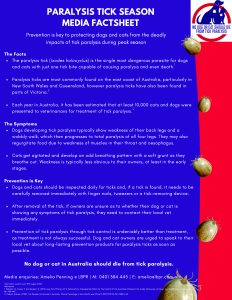As summer heats up and the humidity kicks in, it’s time to protect your pet this tick season. Cases of tick paralysis are already occurring, with leading Cairns vets warning dog and cat owners of the deadly but preventable dangers.
Each year in Australia, it is estimated that at least 10,000 dogs and cats are presented to veterinarians for treatment, with many animals dying as a result of just one tick bite. Leading veterinarians are bracing themselves as they predict a bad season ahead and are calling on pet owners to proactively protect their pets from the deadly parasite to help reduce the potential physical, emotional and financial impact.
Australia’s peak paralysis tick season runs from September to March – the time when paralysis ticks are most abundant,1 but can vary region to region. Unique to Australia’s eastern seaboard, the paralysis tick – Ixodes holocyclus – causes a huge problem to tackle every year and is the single most dangerous parasite for dogs and cats with just one tick capable of causing paralysis and even death.2 Due to the devastating effects of paralysis tick on dogs and cats, treatment following infestation is not always successful.3
Dr Max Fargher, lead vet My Pet Hub, Cairns, is urging Cairns dog and cat owners to prioritise prevention, avoiding an expensive and sometimes heartbreaking trip to the vet.
“It’s peak paralysis tick season in Australia, and I have seen the devastating outcome for both pets and owners when protective paralysis tick treatments are not administered,” says Dr Fargher.
“Unfortunately for us in Cairns and tropical North Queensland, the high humidity provides the ideal environment for paralysis ticks, which means there can be a lot of them around and they can kill your pet.
“Now is the time to talk to your local vet about a paralysis tick and flea treatment plan for your dog or cat to help protect them now and in the future.”
To effectively minimise the risk of tick paralysis, pet owners are encouraged to address three key areas:
Preventative treatment – Every at-risk dog and cat should have access to effective tick protection treatment. Pet owners need to be educated on how severe tick paralysis can be and how effective treatments are in preventing this disease and its potentially fatal consequences.
Daily inspections – Daily inspection gives the best chance of finding a paralysis tick before severe symptoms develop. Use your finger tips to feel your pet’s coat. Start at the head and work your hands down to each paw, ensuring you check every fold and between each claw for any lumps. If you find a tick, consult your vet immediately so that they can show you the best removal method.
Symptoms – Dog and cat owners need to stay vigilant because death can occur if symptoms aren’t noticed quickly enough. Dogs developing tick paralysis typically show weakness of their back legs and a wobbly walk, which then progresses to total paralysis of all four legs. They may also regurgitate food due to weakness of muscles in their throat and oesophagus. Cats get agitated and develop an odd breathing pattern with a soft grunt as they breathe out. Weakness is typically less obvious to their owners, at least in the early stages.

References:
- https://www.researchgate.net/publication/324180376_Tick_Paralysis_of_Animals_in_Australia
- Webster, M., Fisara, P. and Sargent, R. (2011) Long-Term Efficacy of a Deltamethrin-Impregnated Collar for The Control of The Australian Paralysis Tick, Ixodes Holocyclus, On Dogs. Australian Veterinary Journal, 89; 439-443.
- Atwell, Campbell and Evans. (2001) Prospective survey of tick paralysis in dogs. Australian Veterinary Journal, 79; 412-418.





